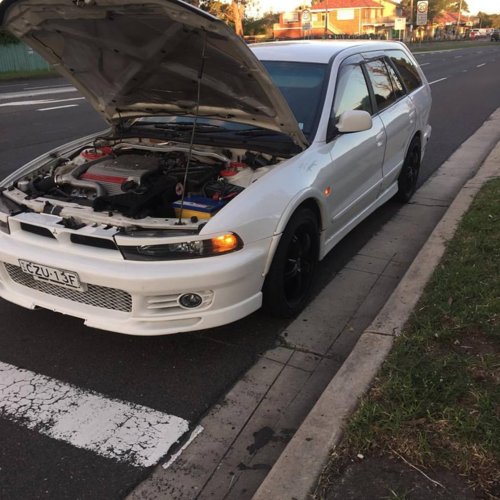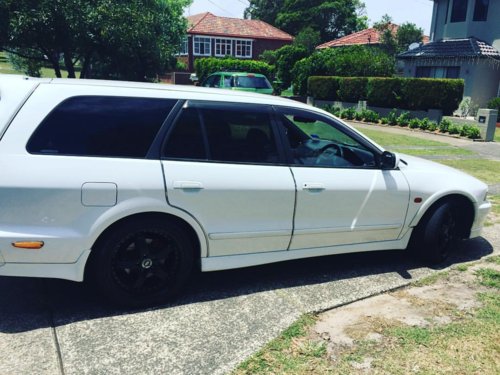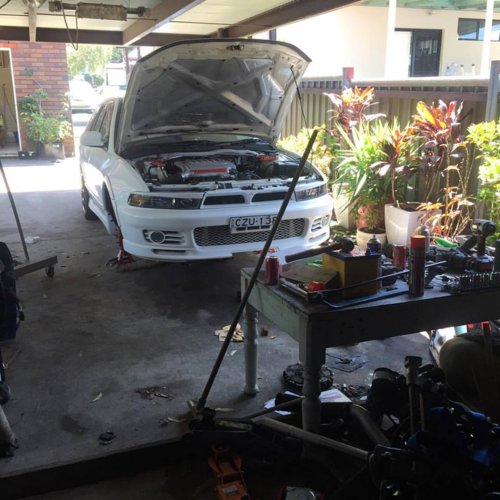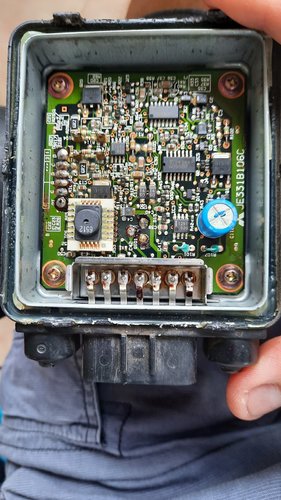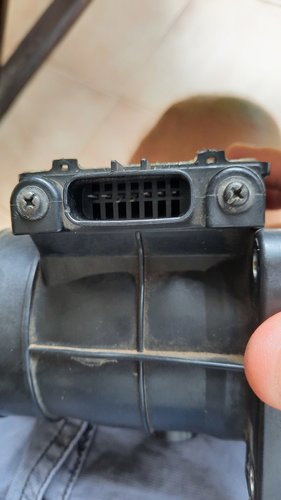Fl0w
Idling at the Lights
- Location
- Australia
- First Name
- Kalven
- Drive
- 1998 Mitsubishi Legnum.
2010 Kawasaki ninja 250cc
1996 BMW 318I.
So decided I wanted a wagon AWD for snow this year.
Always loved sleeper wagons, have in the past owned multiple hatch sleepers from 626 turbo's to vl wagon turbos.
I'm a mechanic by trade so nothing usually fazes me ha.
Choices where basically Legnum or stagea in my price bracket, I loath Nissan with a passion and love EVO's so Leggy it was.
Bought the car with 10 minutes worth of clutch left in it (Literally had to flat tow it 100 metres to my driveway from finally kicking it on the way home)
Chucked a exedy HD clutch in it over the weekend. Went to drive away and engine stalls out... HUGE over fueling issue black smoke could literally smell the fuel.
We assumed it was low fuel or bad fuel, so filled it up with 98 after it sitting for a couple of days and it came good for a little while.
Happened to me once or twice after that, Ended up replacing the positive battery terminal since it was buggered.
Came good for like 2 months after that with 0 hickups. Then BAM! out of nowhere missfires in my face again in Canterbury like an hour and a half away from home.
Left it for the night hoping it would come good which it did not. Ended up paying for a tow truck to work.
Tested coils and thought I'd found a buggered coilpack so bought some second hand coils and she came good for a day again! Drove her home with 0 hickups and she was going fine.
Next morning decide to take her to work 100 metres down the road missfires again lol.
Unplugged MAF while missing and found if you blip the revs up she'll come good and stop missfiring.
Checked for codes and got no codes, Ripped plugs out today all 6 are fouled, but that's not surprise since it's been over fueling this whole time.
Leads are within spec, 681, 658, 565. NGK 0.9's so they shouldn't be an issue.
So at this point I'm thinking Fuel pump, MAF, TPS, etc. Probably going to have to fork out for a 1.3u cable and set up evoscan on my laptop -_-.
Cars spent more time dead on my driveway than it has being driven and it's starting to do my head in lol.
Uploaded some photo's just to show you at least it looks pretty ha.
ha.
On top of the other issues, dude before me was a spaz.
Vac lines deterioated, Wiring nightmare on footwell from ripped out HIDS, Boost gauge wasn't even connected.
Rear diff mounts are completely shot, NSF balljoints are rooted from him replacing a control arm by himself, ALSO he managed to not even do any of the bolts up correctly leaving me almost losing a control arm while driving. Luckily I managed to find that while Doing clutch before it would of actually been an issue.
So yeah, here's my leggy that's basically sat in my driveway for 3 or 4 months now -_-
Always loved sleeper wagons, have in the past owned multiple hatch sleepers from 626 turbo's to vl wagon turbos.
I'm a mechanic by trade so nothing usually fazes me ha.
Choices where basically Legnum or stagea in my price bracket, I loath Nissan with a passion and love EVO's so Leggy it was.
Bought the car with 10 minutes worth of clutch left in it (Literally had to flat tow it 100 metres to my driveway from finally kicking it on the way home)
Chucked a exedy HD clutch in it over the weekend. Went to drive away and engine stalls out... HUGE over fueling issue black smoke could literally smell the fuel.
We assumed it was low fuel or bad fuel, so filled it up with 98 after it sitting for a couple of days and it came good for a little while.
Happened to me once or twice after that, Ended up replacing the positive battery terminal since it was buggered.
Came good for like 2 months after that with 0 hickups. Then BAM! out of nowhere missfires in my face again in Canterbury like an hour and a half away from home.
Left it for the night hoping it would come good which it did not. Ended up paying for a tow truck to work.
Tested coils and thought I'd found a buggered coilpack so bought some second hand coils and she came good for a day again! Drove her home with 0 hickups and she was going fine.
Next morning decide to take her to work 100 metres down the road missfires again lol.
Unplugged MAF while missing and found if you blip the revs up she'll come good and stop missfiring.
Checked for codes and got no codes, Ripped plugs out today all 6 are fouled, but that's not surprise since it's been over fueling this whole time.
Leads are within spec, 681, 658, 565. NGK 0.9's so they shouldn't be an issue.
So at this point I'm thinking Fuel pump, MAF, TPS, etc. Probably going to have to fork out for a 1.3u cable and set up evoscan on my laptop -_-.
Cars spent more time dead on my driveway than it has being driven and it's starting to do my head in lol.
Uploaded some photo's just to show you at least it looks pretty
On top of the other issues, dude before me was a spaz.
Vac lines deterioated, Wiring nightmare on footwell from ripped out HIDS, Boost gauge wasn't even connected.
Rear diff mounts are completely shot, NSF balljoints are rooted from him replacing a control arm by himself, ALSO he managed to not even do any of the bolts up correctly leaving me almost losing a control arm while driving. Luckily I managed to find that while Doing clutch before it would of actually been an issue.
So yeah, here's my leggy that's basically sat in my driveway for 3 or 4 months now -_-


